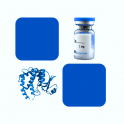
- Remove this product from my favorite's list.
- Add this product to my list of favorites.
Products
Viewed products
Newsletter
 |  |  |  |  |  |

Background
ErbB3, also known as Her3 (human epidermal growth factor receptor 3), is a member of the epidermal growth factor receptor (EGFR) family of receptor tyrosine kinases. This membrane-bound glycoprotein has a neuregulin binding domain but has not an active kinase domain. It therefore can bind the ligand but cannot mediate the intracellular signal transduction through protein phosphorylation.
However, it does form heterodimers with ErbB2 or other EGFR members responsible for tyrosine phosphorylation to give a receptor complex and initiate the related pathway, which lead to cell proliferation or differentiation. Overexpression of this protein has been reported in numerous cancers, including prostate, bladder, and breast tumors. This protein has different isoforms derived from alternative splicing variants, and among which, the secreted isoform lacking the intermembrane region modulates the activity of membrane-bound form.
Source
Recombinant Human ErbB3, His Tag (ER3-H5223) is expressed from human 293 cells (HEK293). It contains AA Ser 20 - Thr 643 (Accession # P21860-1).
Predicted N-terminus: Ser 20
Molecular Characterization
This protein carries a polyhistidine tag at the C-terminus.
The protein has a calculated MW of 70.5 kDa. The protein migrates as 70-80 kDa under reducing (R) condition (SDS-PAGE) due to glycosylation.
Endotoxin
Less than 0.1 EU per μg by the LAL method.
Purity
>95% as determined by SDS-PAGE.
>90% as determined by SEC-MALS.
Formulation
Lyophilized from 0.22 μm filtered solution in PBS, pH7.4 with trehalose as protectant.
Reconstitution
See Certificate of Analysis for details of reconstitution instruction and specific concentration.
Storage
For long term storage, the product should be stored at lyophilized state at -20°C or lower.
Please avoid repeated freeze-thaw cycles.
This product is stable after storage at:
-20°C to -70°C for 12 months in lyophilized state;
-70°C for 3 months under sterile conditions after reconstitution.
Bioactivity
Please refer to product data sheet.
(1) "Identification of potential drug targets for allergic diseases from a genetic perspective: A mendelian randomization study"
Wang, Pang, Zhou et al
Clin Transl Allergy (2024) 14 (4), e12350
(2) "Frequency and Nature of Genomic Alterations in ERBB2-Altered Urothelial Bladder Cancer"
Leary, Enright, Bakaloudi et al
Target Oncol (2024)
(3) "Extraction of Innate Immune Genes in Dairy Cattle and the Regulation of Their Expression in Early Embryos"
Wang, Guo, Zhang
Genes (Basel) (2024) 15 (3)
Showing 1-3 of 2751 papers.
Follow us